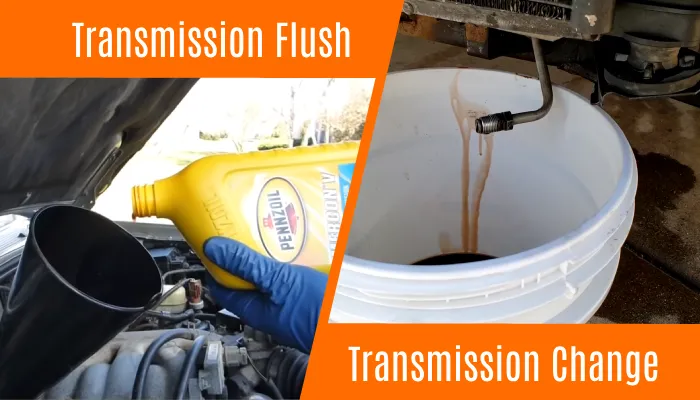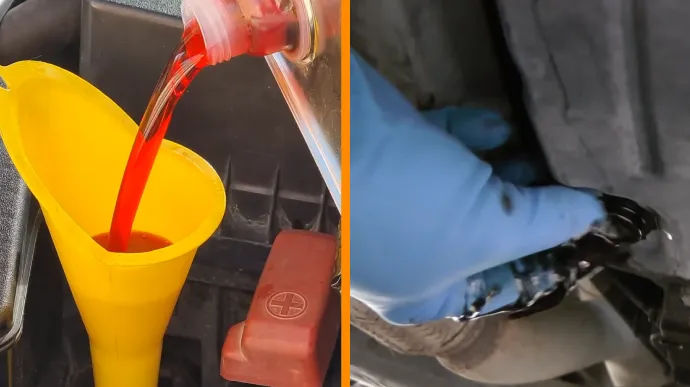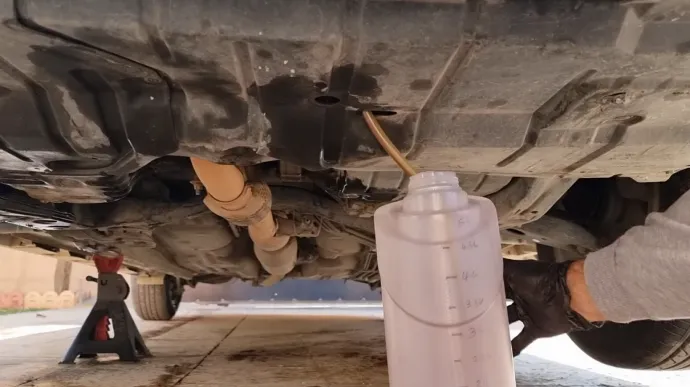Physical Address
304 North Cardinal St.
Dorchester Center, MA 02124
Physical Address
304 North Cardinal St.
Dorchester Center, MA 02124

One of the most critical aspects of vehicle service is maintaining the transmission fluid. Many car owners often face the dilemma of whether to flush the transmission fluid or change it. Although flushing transmission fluid and changing it may sound similar, they have distinct differences.
Changing transmission fluid typically replaces only a portion of the old fluid. This replaces approximately 20% to 40% of the old fluid and then fills with new fluid.
Conversely, flushing transmission fluid involves a more thorough extraction of old fluid, aiming to replace up to 95-100% of the old fluid. This cleans the entire system and improves overall performance and longevity.
Throughout this article, we will explore the differences between transmission fluid changing and flushing. We will also discuss signs indicating you need a transmission flush or change. So keep reading for detailed information.

There are several key points to keep in mind when you are deciding between flushing or changing transmission fluid.
A transmission fluid change doesn’t replace all the old fluid. Some of the older fluid remains in the system. When you opt for a fluid change, only approximately 20% to 40% of the existing fluid is replaced. This method involves dropping the transmission pan, draining the fluid, and replacing the filter if necessary.
As opposed to this, a transmission fluid flush is a more thorough process that removes all the old fluid from the transmission. A fluid flush replaces a significantly higher percentage of the old fluid, typically up to 95-100%.
This process cleans the transmission, torque converter, and cooler, leaving you with fresh, clean fluid that ensures optimal performance by eliminating any contaminants.
Manufacturers typically advise changing the transmission fluid every 30,000 to 50,000 miles. This regular change helps maintain smooth transmission operation and extends the lifespan of your transmission.
Conversely, a fluid flush is recommended every 60,000 to 90,000 miles. The longer interval reflects the more comprehensive replacement of old fluid and contaminants. Flushing the transmission fluid removes accumulated dirt, debris, and sludge, effectively cleaning the entire system.
Flushing transmission fluid is more effective than changing it because it completely removes all old fluid and contaminants, resulting in improved performance and protection for the transmission system.
During a fluid change, only a portion of the dirty fluid is replaced, which does provide some benefits such as improved lubrication and performance.
However, a flush goes a step further by eliminating all the old fluid and contaminants that may be circulating in the system. This not only ensures that the transmission operates at cooler temperatures but also provides better protection against wear and tear.
For a transmission fluid change, basic tools such as a wrench and a drain pan are typically required. These tools allow you to remove the old fluid by loosening the drain plug and collecting it in the pan. Once drained, you can then refill the transmission with new fluid using a funnel.
On the other hand, a transmission fluid flush necessitates specialized equipment, specifically a transmission flushing machine. This machine is designed to remove the old fluid and refill it with new fluid more effectively. It uses pressure and a series of hoses and valves to flush out the old fluid from the transmission system.
To save time, opt for a transmission fluid change rather than a flush, which typically takes less time. A fluid change involves draining the old fluid and replacing it with new fluid, which can be done relatively quickly.
However, a fluid flush is a more time-consuming process. It requires a machine to pump out all the old fluid and replace it with new fluid, ensuring a thorough cleaning of the transmission system. This meticulous process can take longer and may affect your schedule if you wait for the service to be finished.
When you opt for a fluid change, some old fluid remains in the system, which means that any existing deposits or contaminants may still impact your transmission components.
Meanwhile, a transmission fluid flush is designed to clean the transmission and remove contaminants thoroughly. This process can have a positive impact on the performance and longevity of your transmission components.
A fluid change is more budget-friendly, costing around $100 for both manual and automatic transmissions. However, a flush typically comes with a higher price tag, averaging around $150. The increased cost of a flush is due to the specialized equipment and labor involved.
| Aspect | Transmission Fluid Change | Transmission Fluid Flush |
| Fluid Replacement Percentage | Approximately 20-40% | Up to 85-90% |
| Recommended Mileage Intervals | Every 30,000 – 50,000 miles | Every 60,000 – 90,000 miles |
| Effectiveness | Doesn’t remove all old fluid | Removes all old fluid |
| Cost | Generally lower, around $100 | Slightly higher, around $150 |
| Old Fluid Removal | Some old fluid remains | Removes all old fluid |
| Equipment Used | Basic tools, DIY-friendly | Specialized machine, professional |
| Speed of Service | Faster | Slower |

If you’re experiencing poor acceleration, slipping gears, a transmission whine, or harsh shifting, these could be signs that you need a transmission flush.
Poor acceleration can be a clear indicator that your transmission fluid is dirty and needs to be flushed. When the transmission fluid becomes contaminated with debris, it can hinder the smooth operation of the transmission, resulting in sluggish acceleration.
Also, a transmission that isn’t functioning properly can cause a delay in power delivery, causing your vehicle to struggle when accelerating.
When your vehicle’s transmission starts slipping gears, it indicates that a transmission flush may be needed to restore optimal performance and avoid potential issues. Slipping gears occur when the transmission fails to engage properly, causing a momentary loss of power or a delay in shifting.
This can be caused by a buildup of debris or contaminants in the transmission fluid, which can hinder the proper functioning of the gears. By performing a transmission flush, the old fluid is completely drained and replaced with fresh fluid, effectively removing any accumulated contaminants.
Transmission whine is a common sign that your transmission fluid may be contaminated or degraded, causing the gears to produce an abnormal noise. Various factors, such as worn-out bearings, low transmission fluid levels, or a clogged filter, can cause this whining sound.
A transmission flush involves completely draining the old fluid, flushing out any debris or contaminants, and refilling it with fresh fluid.
If you’re experiencing harsh shifting, it may be a sign that you must consider getting a transmission flush. Harsh shifting is a sudden, jarring movement when changing gears, usually accompanied by a noticeable jerk or lurch.
This can occur in manual and automatic transmissions and indicate a buildup of debris, sludge, or worn-out fluid in the transmission system. Over time, these contaminants can hinder the smooth operation of the gears, causing them to engage harshly.
To determine whether to get a transmission flush or change, assess your vehicle manufacturer’s recommendations in the owner’s manual. The owner’s manual will provide specific guidelines on when and how to maintain your transmission.
Some manufacturers may recommend a transmission flush as part of regular maintenance, while others may suggest a fluid change. Consider your manufacturer’s recommendations and the age and condition of your vehicle when deciding which option is best for you.
A transmission flush typically takes 30-40 minutes to complete, providing a thorough cleaning and replacement of old transmission fluid.
During the process, custom-blended chemicals are used to power-flush out the old fluid and contaminants from the system. This ensures that any build-up or debris is removed, allowing optimal transmission performance.
The fresh transmission fluid is then pumped into the system, ensuring that the transmission is properly lubricated and protected. Note that the flush duration may vary depending on the specific vehicle and its condition. However, you can generally expect the process to be completed within the time above frame.
Neglecting to change your transmission fluid can lead to serious consequences for your vehicle’s performance and longevity.
Over time, the transmission fluid becomes contaminated with dirt, debris, and metal particles. This contamination can cause the fluid to lose its lubricating properties and become less effective at cooling the transmission system.
As a result, the transmission can overheat, leading to excessive wear and damage to the internal components. Also, the contaminated fluid can cause increased friction and slippage in the transmission, resulting in poor shifting performance and reduced fuel efficiency.
It’s essential to regularly flush and change your transmission fluid to maintain the proper functioning of your vehicle. Ignoring this maintenance task can lead to serious transmission issues and costly repairs.
While flushing may seem a better option, changing the transmission fluid is more appropriate for older vehicles or those with worn-out gaskets. Regardless of your choice, it’s essential to maintain your vehicle’s transmission fluid to ensure your car is operating correctly.
Therefore, prioritize the regular flushing and changing of transmission fluid to avoid expensive transmission problems.